Forts and Palaces - Forts and Palaces in Rajasthan
|
|
|
|
Forts and Palaces
in Rajasthan |
| |
|
Rajasthan's history lies inducted in its forts and palaces. Some of
the forts were abandoned, and captured, leaving behind a rich
history. The palaces which were built outside the forts belongs to
the 19th and 20th centuries and the forts are very old.
These forts and palaces provide a rich heritage of Indo-Saracenic
architecture, impacted by the Mughals, British and Rajputs. The
spectacular palaces and forts were constructed by various rulers and
architects, outside the walled city and used to safeguard the city
from the foreign invaders and were also built on high hills
overlooking the city. Some of the prominent forts and palaces
in Rajasthan are as follows: |
| |
|
Chittorgarh
Fort, Chittorgarh
Chittorgarh Fort is the largest medieval fort of India and is also one
of the largest fort of Rajasthan. From Chittorgarh Fort the Sisodias
went to war against the Mughals at the well-known battle of Haldighati.
Chittorgarh fort was founded in the 7th century, and became the seat
of the Sisodia rulers. This fort is situated on a 152 m rocky high
hills of the Aravallis range and gave Chittorgarh a great strategic
significance. This fort is protected by seven impressive gates. The
Chittorgarh fort was sacked in 1303 through an act of betrayal done by
Allauddin Khilji to win the Rani Padmini and was sacked more in the
16th century, first to the forces of the Sultan of Gujarat, and then
to the Akbar. |
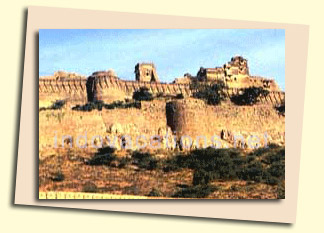 |
|
|
This fort was later abandoned by its rulers and
some apartments, palaces and durbar halls were
destroyed. Some of the palaces which were destroyed
are Rani Padmini’s palace, Rana Kumbha’s palace,
Jaimal and Patta palace. Some of the buildings that
were protected are the 37-metre high victory tower,
the 22-metre high, 12th century Kirti Stambh and
Vijay Stambh, raised in the 15th century to honor a
battle victory against the rulers of Gujarat and
Malwa. Temples visited within the fort are Meera
temple, Kalika Mata temple and Kumbha Shyam temple.
More.... |
| |
|
Junagarh
Fort, Bikaner |
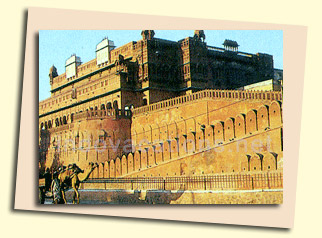 |
Junagarh fort was founded in 1593 in Bikaner by Raja Rai Singh to
safeguard the 37 palaces, pavilions and shrines. Raja Rai Singh was
the general in the army of the Mughal Emperor Akbar. He built the 986 m. long Junagarh fort by
red sandstone and is surrounded by a moat around the modern city of
Bikaner is spread. The Junagarh fort is a very unexampled fort and was
not conquered till date, except when Kamran captured it but could not
retain it for over 24 hours. This fort has 37 pavilions which look
very magnificent in the morning and evening. The large columns,
arches, delicate stone screens, paintings, minarets, and statues in
the fort always attract the visitors. Junagarh consists of some
apartments and palaces which are in a remarkable state of
preservation. There are some palaces which are wonderfully adorned
like Chandra Mahal, and Anup Mahal. These palaces give the impression
of a rich inlay of peitra dura. |
|
|
The
apartments are painted very lavishly and have been conserved due to the
very dry heat situations of the desert town. The Badal Mahal has paintings
of clouds on its walls. Wooden Durbar Hall and a set of sandstone
staircases were added in this palace by the Maharaja Ganga Singh.
More....
|
| |
|
Kumbhalgarh
Fort, Kumbhalgarh |
|
Kumbalgarh Fort was the 2nd most prominent fort of the
Mewar kingdom after Chittorgarh Fort. This invulnerable fortress was raised in
the 15th century by Rana Kumbha, and perched on the top of 13 mountain
peaks in the Aravallis. This fort also conferred refuge to the prince
Uday who was smuggled out of Chittorgarh by his nursemaid Panna Dai,
and it was from here that he ruled before setting up the new capital
at Udaipur. This fort also conferred refuge to the Mughal prince,
Jehangir. The fortifications of the fort are 36 km long which
safeguard the bastions of the fort that over-hung with steep walls. A
steep climb up a narrow road leads to the entrance of the fort. From
the fort a very beautiful and strategic view of the lower land can be
seen. Badal Mahal within the fort is famous for its beautiful
interiors and its tall height as compared to other structures. |
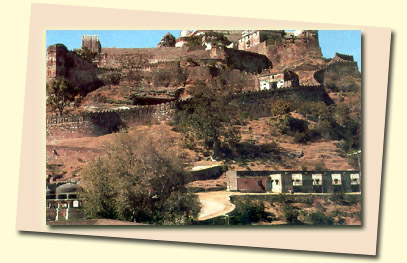 |
|
|
The ancient Jain temples belonging to the Mauryan era, medieval
Hindu temples with fluted pillars, and a few monuments or chhatris can
also be seen here. The buildings at Kumbhalgarh are mainly intact.
More....
|
| |
|
Mehrangarh
Fort, Jodhpur |
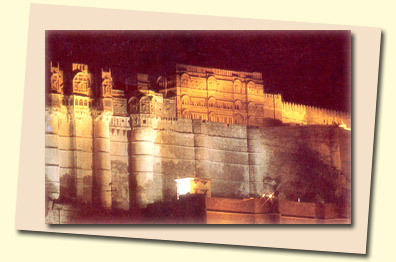 |
Mehrangarh fort is a very magnificent hill forts of Rajasthan.
Mehrangarh fort appears to rise from the bluff-coloured sandstone hill
itself, and so built properly into the base in such a way that it is
difficult to tell where the walls begin and the hill ends. Mehrangarh
fort is superb and forbidding from the outside. In 1459 AD, Rao Jodha
was once advised by a saint to set up an
impermeable headquarter and so the Mehrangarh fort was founded by Rao
Jodha on a steep hill. The fort is easily reachable by a series of
seven gateways. Across the large courtyards of the fort there are the lavish
apartments, with the elegantly latticed windows. Only a few palaces of
this fort are open to visitors. Presently this fort is maintained and
managed as a museum by the royal trust. These palaces were built by
Rao Jodha and his successors from 1456 AD onwards like Jhanki Mahal,
Moti Mahal etc. |
|
|
Chandan Mahal, Darbar Takhat, Phool
Mahal and Rang Mahal. Some other famous palaces are Sheesh
Mahal, Umaid Vilas and Maan Vilas. From the ramparts of
Mehrangarh, one can also see the art-deco Umaid Bhawan
Palace located on top of Chattar Hill.
More....
|
| |
|
Jaisalmer
Fort, Jaisalmer |
|
The
Jaisalmer fort, stands at an elevation of 100 metres over the city of
Jaisalmer. This fort rises from the sands, and combines with the sand
dunes.
Jaisalmer fort is also known as the Sonar Qila. Jaisalmer fort was
built by Bhatti chief Jaisal in the year 1156.
This
fort is built of yellow sandstone which lusters into a golden flame
when the sun shines on it and provide an amazing view. There is a
complete community within the 99 bastions, which consists of a large
living complex, a palace, Hindu shrines and the havelis of rich Jain
merchants.
The Sonar fort is reachable through Suraj Pol, Hawa Pol, Ganesh Pol,
and Akshya Pol. Some entrances also guard the Jawahar Mahal and Megh
Darbar which bear the imposing symbols of the Bhatti clan's lunar
lineage. Presently, the 19th century Abdul Mahal (Palace of Clouds) is
the residence of the previous rulers of Jaisalmer. There are some very
spectacular royal apartments like the Moti Mahal, Gaj Vilas and Rang
Mahal. These palaces have pavilions, pillars and balconies with
graceful stone carving.
More....
|
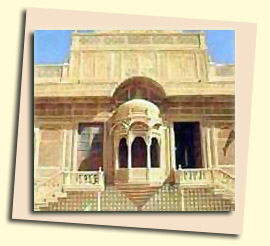 |
|
| |
|
Kota Fort,
Kota |
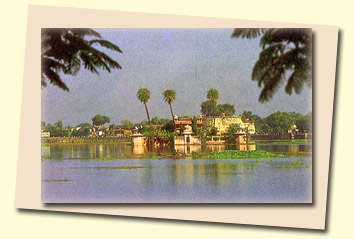 |
Kota
Fort
Kota was once a part of the kingdom of Bundi, and known for its
stirring history of chivalry and bravery. The Kota Fort is a large and
extensive structure and one of the prominent tourist attraction in
Kota, that overlooks the Chambal river. The Kota fort was founded in
the mid 13th century by Jait Singh. This fort houses the museum and
has some lavishly painted chambers. The Kota Fort is famous for its
Durbar Hall which has mirror work and paintings, and has doors of
ivory and ebony.
This fort also has
very high quality of the miniature wall paintings that depict the
hunting scenes.
More.... |
|
| |
|
Taragarh
Fort, Bundi |
|
Taragarh Fort in Bundi is very romantic place of Rajasthan. This fort
was constructed by the Hada Chauhans in the mid-14th century, from the
basalt rocks and the sandstone of the Aravallis.
This fort is located within the horse-shoe shaped hills, and lakes and
water reservoirs, and conserved by the Aravalli hills. In the Bundi
Palace complex, there are some apartments of private residences and
public affairs. Some of the very high quality of wall paintings
can be seen in the Chandra Mahal and the Chitrashala or picture
gallery founded in the 18th century by Rao Raja Umed Singh. These
paintings reveals scenes from the life of Krishna, and are remarkable
for their blue-green tints.
More.... |
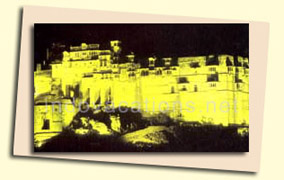 |
|
| |
|
Lohagarh Fort, Bharatpur |
|
Lohagarh'
means 'fort of iron'. Lohargarh always stood firm giving Bharatpur town
the security it needed. Lohagarh fort is situated on an artificial island
in the heart of the old city of Bharatpur. It was founded in 18th century
by the Maharaja Suraj Mal who was the Jat ruler of Bharatpur. There are
painting of large elephants on the gateways of the fort. This fort was
inaccessible and has bastions of sand that were strong enough to absorb
the impact of canon shells that simply embedded themselves within it. One
can reach the fort through the large entrance gate from the crowded
street. Monuments inside the fort include the following: Kothi Khas, Mahal
Khas and Kishori Mahal. Moti Mahal and towers like Jawahar Burj and Fateh
Burj were built to honor the victory over the British army and the
Mughals. |
| |
|
Amber Fort,
Jaipur |
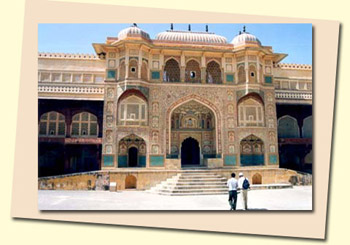 |
Amber Fort is located about 10 km from the city of
Jaipur. Before moving to Jaipur, Amber was the
ancient capital of Kachhawaha dynasty for 6
centuries. While many of the early structures are
either vanished or destroyed from the fort, but
those belonging to 16th century onwards are
present very properly inside the fort. The
existence of Amber Fort belongs to various rulers
like Raja Jai Singh I and II and Raja Man Singh.
The Amber Fort is a unique combination of Hindu
and Mughal architecture, built in white marble and
red sandstone. The palace complex has various
staircases, narrow passages, gardens, palaces and
apartments, windows, courtyards, high walls,
halls, pillared pavilions shrines, separated by
some gates. Some of these architectural wonders
are Sukh Niwas, Diwan-E-Khas, Sheesh Mahal,
Diwan-E-Aam, Jai Mandir with beautiful mirror
work, Shrine of Shila Mata, Kesar Kyari and Shrine
of Kali and a well laid out garden.
More.... |
|
| |
|
Bala Kila,
Alwar |
|
The "Bala
Kila" or the Bala Fort is situated on the most famous hill of Aravallis
range depicts the rich history of Alwar. Bala Kila is also known as the
Kunwara Kila. This huge medieval fort has 15 large and 51 small
towers, 446 openings for musketry and 8 large towers that rises about 3000
m above the city. Some of the Mughal rulers also stayed here before it was
reverted back to the Rajput rulers in the 18th century.
The fort is circumscribed with several gates
known as Pols like Jai Pol, Laxman Pol, Suraj Pol. Salim
Mahal, which lies in ruins now, is said to have been the
palace where Prince Salim, later the Mughal Emperor Jehangir,
spent his three-year exile.
More.... |
| |
|
Jaigarh Fort,
Jaipur
Jaigarh Fort was founded by Sawai Jai Singh in the year 1726. Jaigarh
fort stands on a small hillock between the thorn scrub hills
overlooking the city of Jaipur. Jaigarh fort is also known as Victory
Fort. The fort is surrounded by huge battlements with
various walkways offering stunning views on all sides.
From
the Dungar Darwaza, the main gate of the fort, there is a beautiful
view of the Jaipur city. Important attraction inside the Jaigarh Fort
is the Jaivana, which is the world's largest cannon on wheels. It was
constructed in the 1720 in Jaigarh's foundry. There are a large number
of wide water channels in the fort which were a part of rainwater
harvesting system. There is also a small museum and armoury in the
fort. More.... |
 |
|
| |
|
|
| |














